Lucy Black reviews five new picture books that explore ideas of people and place. Join Aroha, Flit, Polly, two boisterous boys and the girls in the kapa haka as they each in their own way show what it is to be a kid in Aotearoa these days.
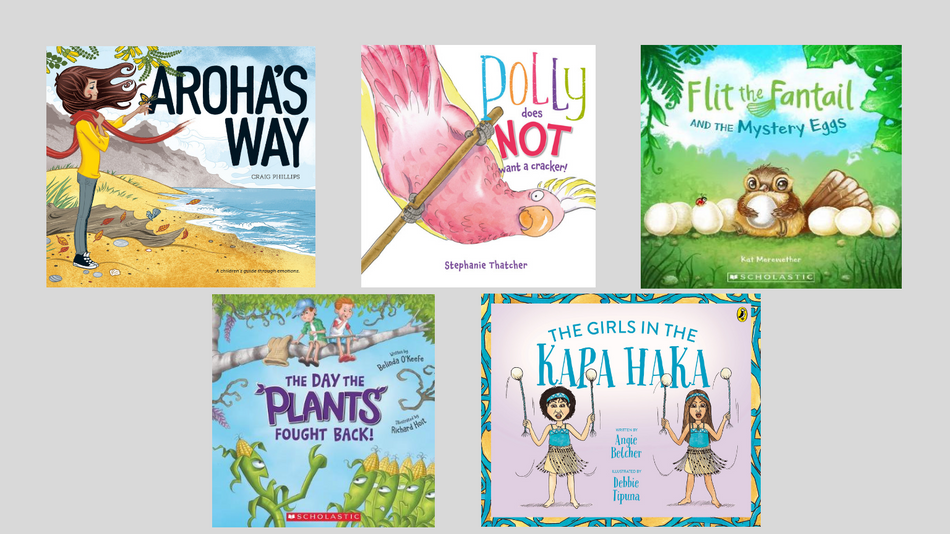
Aroha’s Way by Craig Phillips (Wildling Books)
Books about emotions and how to deal with them are some of my favourite kids’ books. I remember being young and reading Aldo by John Burningham, the bittersweet sadness and evocative painted illustrations really meant something to me. I worried for Annie and Moon and Kimi in Miriam Smith’s classic books, feeling an affinity with those anxious, homesick kids. As a teenager, I fell in love with The Red Tree and other Shaun Tan works, the way he pairs his sparsity of text with those pictures!
Complexity of emotions and developing coping skills are hard things for an author to tackle. Aroha’s Way by Craig Phillips is a book about a young girl with nerves, fears and worrying thoughts. The story shows her battling with these feelings and then explores her practical skills in self grounding and calming. Aroha is a relatable character in a relatable, clearly New Zealand setting, with birds, bush and beach.
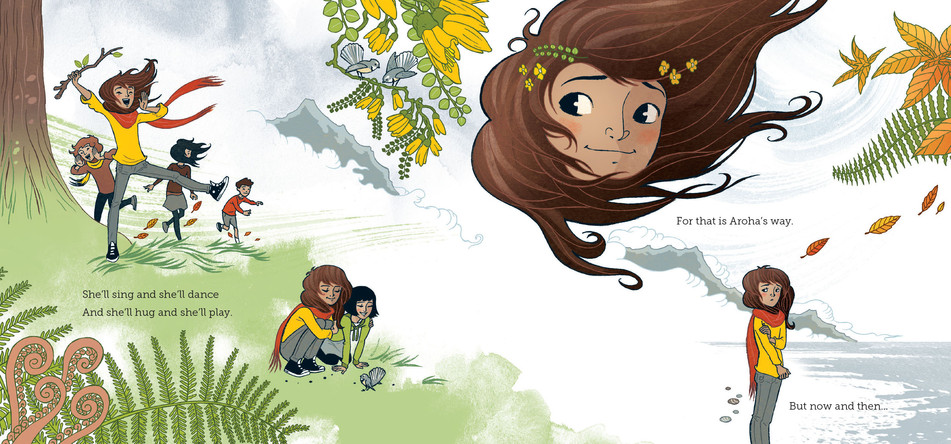
Phillipa is a very precise and dynamic illustrator and the colour palette is refined. The rhyme introduces Aroha as a girl who likes to run, sing, dance and play. As the story carries on, the illustrations cleverly add dimension to the sometimes too simplistic poem. Aroha’s deep sunken eyes show serious apprehension and the fearful paralysis is clearly conveyed as she’s held fast where she stands by invisible strings. It’s an optimistic and positive story that doesn’t linger long over poor Aroha standing at the shore and feeling she’s no good. Very quickly our protagonist is shown hands on hips and smiling like a superhero for ‘Aroha knows what to do!’. Aroha uses movement, breathing and mindfulness to calm herself, she reaches out to friends to share her troubles.
It’s an optimistic and positive story that doesn’t linger long over poor Aroha standing at the shore and feeling she’s no good.
The book finishes with clouds clearing and Aroha perched on some driftwood and smiling with her mates. The reader gets an extra treat with three pages at the end dedicated to Aroha’s ways to help with anxiety. These are more detailed guidelines about exercise, diaphragmatic breathing, mindfulness and talking through anxiety. The author has also provided a list of websites and phone numbers for kids in need of more support.
This is a carefully thought out and well-rounded simple book that I think will be a valuable tool for families, classrooms, counsellors and kids. I hope more of these are published and kids’ mental health continues to be discussed so gracefully, pragmatically and openly.
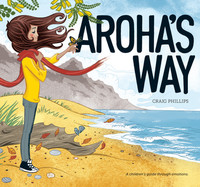
Flit the Fantail And The Mystery Eggs, by Kat Merewether (Scholastic NZ)
Flit the Fantail and the Mystery Eggs is the next instalment in a series by Kat Merewether, who also produces the popular Kuwi the Kiwi books.
Flit the Fantail and the Mystery Eggs is a cute mystery tale about a curious young fantail trying to find who laid the eggs he has found. Flit is like many children’s books protagonists: bright eyed, clumsy, inquisitive and likeable. The story introduces the reader to host of Aotearoa’s birds, plants and reptiles.
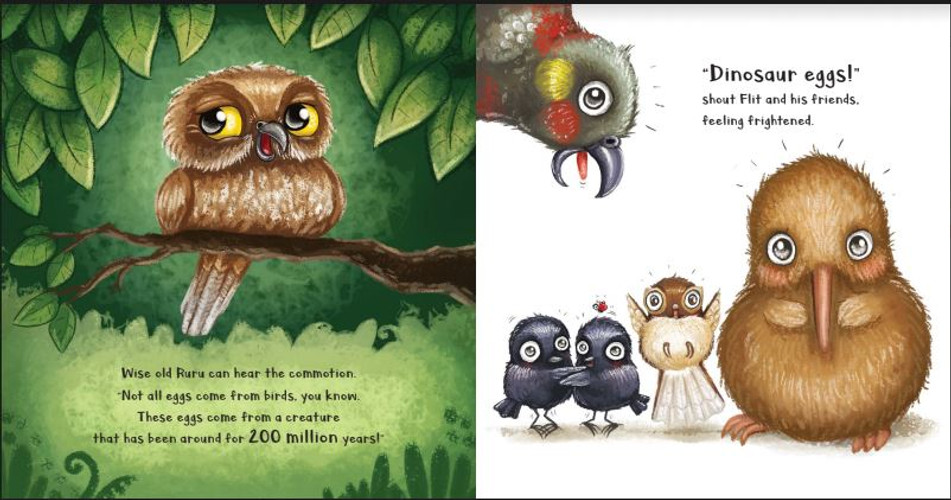
Like most good picture books this one has clues and extra details in the pictures. It is clear Kat Merewether has spent hours on the composition and creation of the lush bush scenes. These details make the book much more enjoyable for young readers, it makes them feel in on the joke when they spot a clue or recognise a native plant, it also makes the multiple readings more palatable for tired adults.
The ‘Aww cute!’ factor is strong. As an adult, I have to say I found the alliteration and whimsical turn of phrase slightly grating at times. The oversized eyes and roly poly bodies of the birds takes away some of the majesty they hold in reality. Perhaps that is part of the appeal for small kids though. I think the onomatopoeia and playful style will attract kindergarten-age kids and I would love to see this published as a board book.
I think the onomatopoeia and playful style will attract kindergarten-age kids and I would love to see this published as a board book.
Caregivers can use Flit’s adventure as a good springboard for talking about feelings, Merewether has carefully inserted lots of feelings words and expressions; Flit wonders, ponders, frets and shows fear and surprise at each turn of the page.
One aspect of this book I found slightly confusing is the choice of when to use Māori or English words. Flit is a fantail but Kiki is a kaka, Bit and Bob are robins but the Ruru is wise. My preference would be for Māori names and I think we are in an interesting period in children’s publishing as language expectations change.
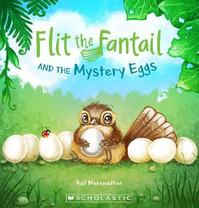
flit the fantail and the mystery eggs
By Kat Merewether
Published by Scholastic NZ
RRP $19.00
The Day The Plants Fought Back, by Belinda O’Keefe Illustrated by Richard Hosk (Scholastic NZ)
The Day the Plants Fought Back is a cautionary tale about two boys who behave badly and trash their garden. The plants become furiously animated and band together in war against the children.
In a stagey rhyme the boys are shown to be disrespectful, boisterous, annoying kids who don’t listen to their clearly over-it mum. I get it, I realise kids aren’t well-behaved all the time, but I think these passages feed into the ‘boys will be boys’ trope.
The kids are banished outdoors after wasting food and wrecking the kitchen. They then go on a rampage in the garden, ripping up vegetables and using them as weapons. The boys delight in breaking their mum’s prize daisy. At this point an angry looking plant army rises up and I’m thinking,’Yay a Lorax moment!’, but yeah not quite. Instead of some valuable teaching about the pleasures of home grown food and respect for the environment, the plants scold and terrorise the kids into acquiescing.
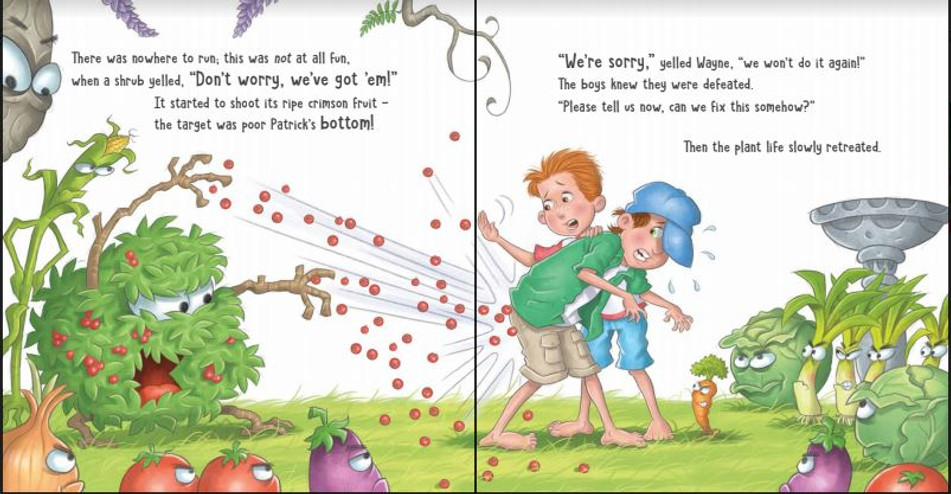
The plants attack and the boys fight back with spades and fists, but the plants are winning and eventually the boys admit defeat. The book finishes up with the boys looking after the garden, but not because of any pride or understanding, just because the plants threaten to torment them further if they don’t, and ‘remember potatoes have eyes’ wink wink.
I think this book is missing out on some deeper level learning about kaitiakitanga and respect. I realise not all books need to be heavy or moralistic but I found The Day the Plants Fought Back to be really lacking in depth. Maybe it could be a fun, silly book for reading aloud and then building on the value of gardening more post reading? Gardening’s great, hopefully most kids can see the merits of home grown food without looming leeks threatening them.
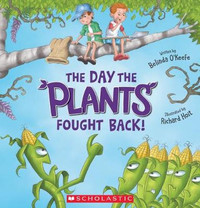
the day the plants fought back!
By Belinda O’Keefe
Illustrated by Richard Hosk
Published by Scholastic NZ
RRP $19.00
Polly does NOT want a cracker! by Stephanie Thatcher
I have a soft spot for books about cantankerous animals. I’ve always liked the Scarface Claws more than the Hairy Maclarys.
Polly does NOT want a cracker! is a straightforward wee story about a grouchy bird. Everyone asks Polly if she wants a cracker and no, she doesn’t. She replies ‘No!’ loudly and rudely to the overused, inane remark and is deemed too unfriendly for the zoo. Polly finds herself in a pet shop where the boring badgering continues, until one day a thoughtful girl called Emma visits.
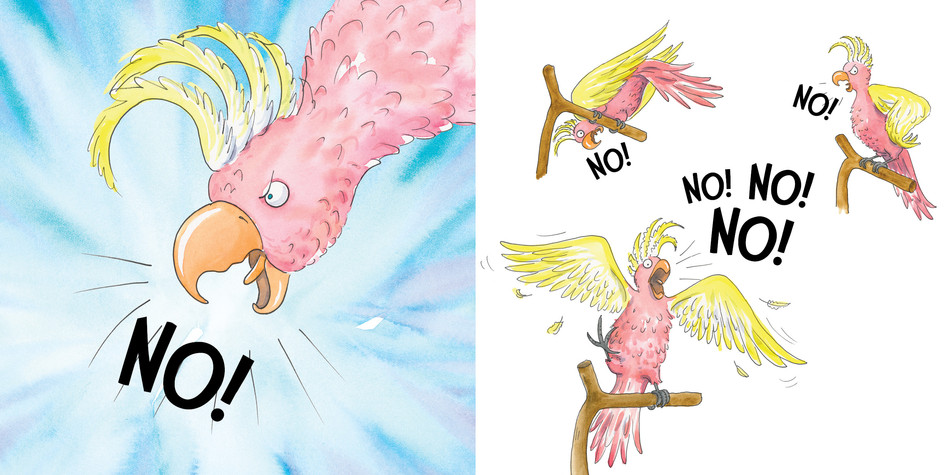
I think this book would appeal to 3-8 year olds because of its bright palette and easy-to-read structure. There are nice touches that appeal to close readers also. I really appreciated the scenes in the zoo and pet shop that showed diversity of families, body types and cultures. It shows that author/illustrator Stephanie Thatcher has thought about who she wants to represent in her story.
I really appreciated the scenes in the zoo and pet shop that showed diversity of families, body types and cultures.
I love it when children’s books casually reflect the array of characters in the books setting. Some of my favourite children’s illustrators like Sarah Garland, Jan Ormerod and Helen Oxenbury do it well, and of course local favourites Gwenda Turner and Robyn Kahukiwa. I think touches like this, whilst they’re not the focus of the book, make a huge difference to the impact the books have.
As you would expect, this endearing story has a happy ending; Polly finds a close friend in Emma, who shows the empathy to ask if Polly would like anything other than a cracker. I guess the hope is that each child who reads this would endeavour to be like Emma, to think outside the box and see beyond cantankerous exteriors.
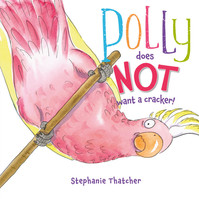
The Girls In The Kapa Haka, by Angie Belcher, illustrated by Debbie Tipuna (Puffin NZ)
The Girls In The Kapa Haka is a very simple rhyming picture book about the work behind a primary school kapa haka performance. The story is told along a The House That Jack Built format, beginning, ‘These are the girls that sang in the kapa haka’ and goes on from there. As the book follows the performance it cleverly shows the ways in which the whole community are involved in the event, from the Kuia who made the piupiu to the kaiako who taught the waiata.
The illustrations are dynamic if a little simple, this is a reissue of the book and perhaps it could have done with some building on the original pictures. I think some more arresting images would take this book from a favourite to a classic. It is a very well-paced story, and fun to read aloud to 4-10 year olds. My 8-year-old who has just started kapa haka at school enjoyed having it read to her. Both my kids noticed and appreciated the diversity in the people represented, we liked the different bodies and styles.
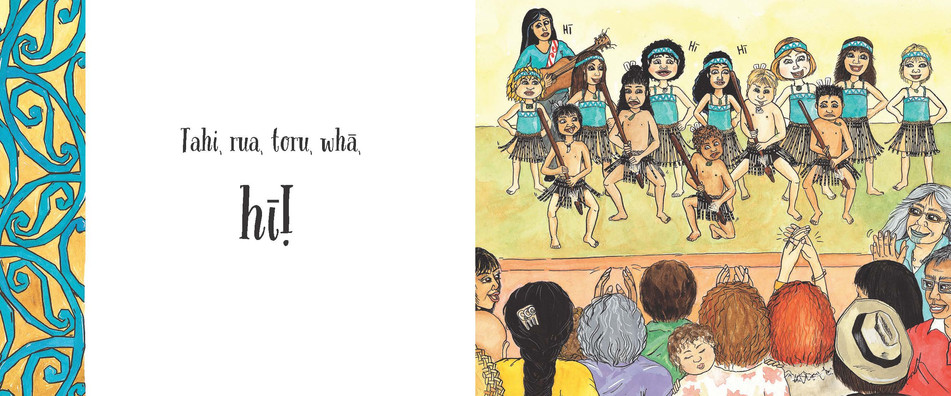
This is an important book to share with our kids, because it shows them how truly centred and loved they can be within our wider communities. Often kids in picture books are in a world seemingly without adults, they’re in their imaginations or on adventures with a pack of kids. In other books they’re seen as an annoyance by parents and part of the plot is conflict with adults and an us vs them aspect. There are of course, lots of children’s books where children are predictably interacting in a nuclear family, fitting into set roles. All of these representations have their place, but it is refreshing when a book does something beyond these templates.
‘This is an important book to share with our kids, because it shows them how truly centred and loved they can be within our wider communities’
The Girls In the Kapa Haka shows a fresh perspective of generous adults lovingly interacting with a group of kids and valuing their talent and time. The book finishes with teachers and families and friends crowding around to cheer as the kapa haka group finish with a loud ‘Tahi, rua, toru, whā, hī!’ .
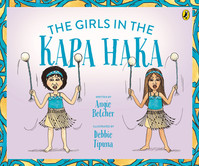
the girls in the kapa haka
By Angie Belcher
Illustrated by Debbie Tipuna
Published by Puffin
RRP: $17.99

Lucy Black
Lucy Black is a writer and reading promoter. She splits her time between the cosy school library she manages and her book-filled home at the edge of the city.



